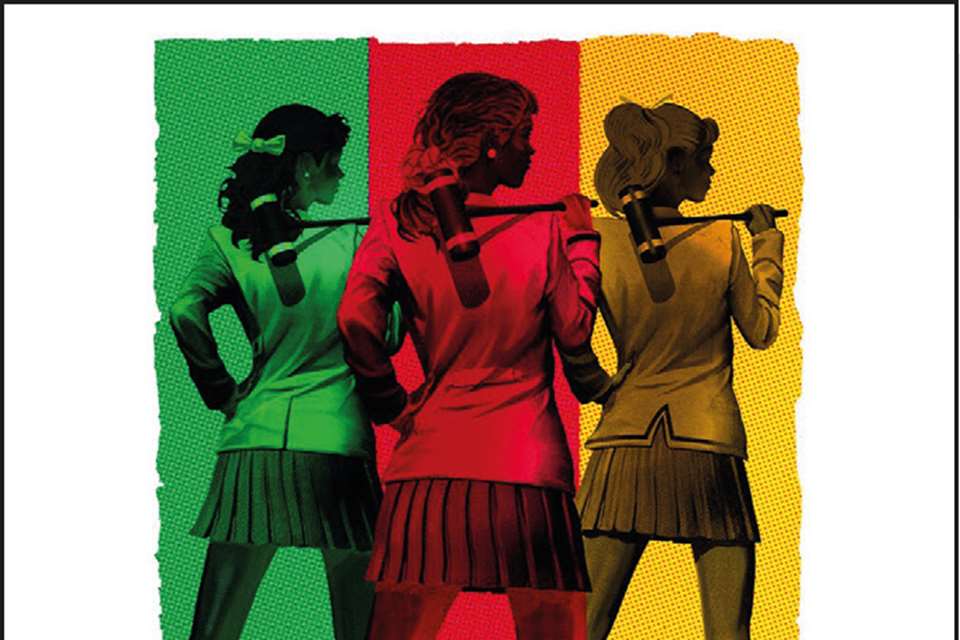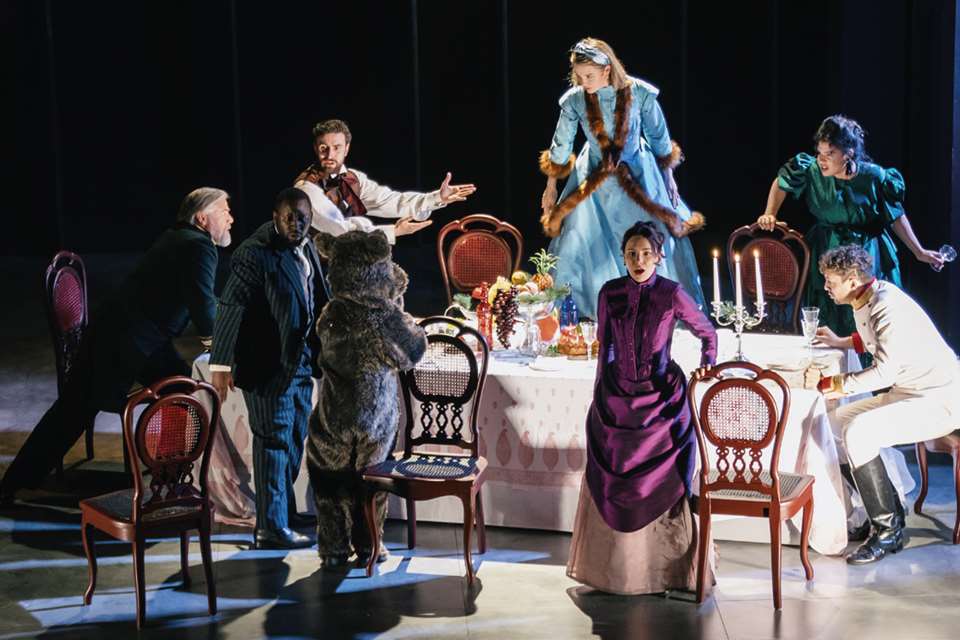Rediscovering the Soho Poly
Hattie Fisk
Friday, September 1, 2023
In the dark depths of the University of Westminster, a lost theatre is experiencing a new lease of life. Hattie Fisk reports from the first ever school workshop in the Soho Poly and meets the team behind the venue's relaunch.

Nobbe Clark
Entering a theatre can be an exhilarating experience. Many of us have been lucky enough to see students walk into an old theatre and completely light up. But what about when that history is lost?
In the dark depths of soho, down a flight of stairs and in a darkened basement room stands the old Soho Poly theatre. You would never have known that greats such as Caryl Churchill, Hanif Kureishi and Simon Callow have performed in that space. Having fallen into disrepair, it is home to little more than a few rows of shelves, cleaning products and cardboard boxes. Blackout curtains are replaced by filing cabinets, and brooms sit in the shadows where stage lights used to illuminate. That is, of course, until now.
The history
Back in 1968, Fred Proud and Verity Bargate founded a theatre company called the Soho Theatre, moving into a basement on Riding House Street owned by the Polytechnic of Central London (now the University of Westminster) in 1972. For 20 years this was known as the Soho Poly, a venue that played a hugely important role in the alternative theatre scene.
The Soho Poly was a huge pioneer of ‘lunchtime theatre’, making theatre more inclusive by bringing the arts into the ordinary working day, and offering opportunities to many artists who were excluded from mainstream theatre. Plays regularly tackled important political issues around race, sex and class, and provided mothers with the chance to see theatre at lunchtime when other productions were only available in the evenings when they were busy with childcare responsibilities. The basement was abandoned in 1990 when Soho Theatre worked in different spaces across the city, before settling in Dean Street where it lives today.
After researching this history, Matthew Morrison began to wander the halls of the University of Westminster searching for where the Soho Poly once lived. After trying different doorways, he eventually found it: a cluttered storage room falling into disrepair at the edge of the university's campus. With a passion for theatre and a vision for what the space could be, Morrison gained support from the University of Westminster and started a fundraising project to restore and revive the Riding House Street venue. After securing contributions from investors to fund community projects, including The National Lottery Heritage Fund and The Quentin Hogg Trust, Soho Poly continues to accept donations so it can continue to produce its programmes.
A hidden gem
Big names have stood in the Soho Poly, including John Hurt and David Warner in the production of The Dumb Waiter in 1973, and Bob Hoskins performing The Bystander in 1977. Many BBC producers from the nearby broadcasting house commissioned their first showcases at the venue, and featured artists and performers have included Hanif Kureishi, Simon Callow and Timberlake Wertenbaker. The space gave voice to underrepresented writers, particularly women, making it all the more tragic when it was abandoned.
‘For 20 years, it had just been turned into a complete junk ground. There were no theatrical fittings, but instead there were filing cabinets tipped over the floor. There was just nothing,’ Morrison passionately explains. After discovering the room in 2012, he kickstarted the 10-year project to revitalise the space and mount pop-up performances, re-engaging students, local residents and the wider London arts community. The walls were given a lick of paint, the space was cleared, new fire doors were put in and removable chairs were placed in the audience area.
As well as ensuring that the space has become safety compliant, Morrison insisted there was an accessible lift. ‘Accessibility is of course important for theatre spaces, but even more so for this one because of its history,’ says Morrison. ‘We want to make sure as many people can access this place as possible. We want it to hark back to what it was in the ‘70s, where anyone was invited.’
University of Westminster alumni including Emmy the Great and journalist Jon Ronson were invited to perform in the Soho Poly after it was rediscovered in 2012 – but many didn't know that they had been studying in the same building as this sacred room. Morrison tells me that returning students often become emotional after learning about its history, vowing to return and contribute to its future.
Welcoming walls
When standing in the space, one thing that took me back was the colour of its walls: brown. Morrison assures me that this is another thing that links the space to the past, as Fred Proud believed that brown was a friendlier colour than black, and they wanted the theatre to be as welcoming as possible for the theatregoers and performers. This makes it so different from the usual blackbox theatres you find around the country. There is a homeliness to the space, and despite it featuring some modern fittings, it gives you with the surreal feeling that you have been transported back to the ‘70s.
A sense of community is threaded through the programme of events staged by the new Soho Poly team (made up of Morrison and other educators and students at the university who volunteer their time for the project). ‘We are really not interested in making this a commercial sort of venture. We also didn't want it to become another room for the university to put on the teaching timetable.’ Although quirky, the space looks similar to the way it did at the height of its history, and all attempts at making it a functional or characterless theatre space have been keenly avoided.
In exchange for not charging rental fees for the venue, Soho Poly instead asks performers to contribute to community projects or workshops alongside their shows. By operating with this system, the venue can maximise its value in the local community and establish a cycle of collaboration between the audience and performers.
Young people and the community
When I visited Soho Poly, I was lucky enough to sit in on the first ever schools workshop taking place, led by playwright Ben Musgrave. The session was with students from the Lister Community School, Newham, who became involved with the venue through a National Lottery scheme. The KS3 students were glowing, clambering together to form a big ‘monster’ under Musgrave's instruction, reading out dialogue as they did so. The dark brown performance space was adorned with bunting strung from left to right of the ceiling – the product of a previous creative session run in the opening week of the relaunch.
As part of the project, an educational resource pack has also been launched influenced by the venue's past. Its resources are intended for use by teachers and students, and it is crammed full of interviews, discussion points, activities and practical advice for future theatre makers. Other events in the relaunch week included musical performances from Ashaine White, button-making workshops, a postcard poem scheme between young people and elderly members of the community and readings from creatives.
 © CLAUDIA CANTARINI
© CLAUDIA CANTARINI
Musician Ashaine White performing at the Soho Poly's relaunch festival
A bright future
Moving forward, the plans just get grander. The renovation has meant that new events can take place, including art exhibitions, poetry and spoken-word festivals, a new Soho Poly Music Club and LGBTQ+ Drama Club, creative writing courses in partnership with older people's charity Open Age and regular community workshops. Alongside this, there are plans to introduce a long-term partnership network with local schools to create further workshops and run mentorship programmes and internships for students.
With the rise of digital theatre, it is easy for students to experience theatre on screens in the classroom or at home. While this is a brilliant development, physical experiences are invaluable for students, especially for impressionable Key Stage 3 pupils who may never have been to the theatre before. Creating magic in an unused space, and paying homage to the work of the past, this is a beautiful project for the local community – young and old people alike. If you are based in London, I highly recommend investigating the Soho Poly. You never know, one of your students could be the next big name to set foot on its stage.
westminster.ac.uk/about-us/alumni-and-supporters/support-us/restoring-the-sohopoly







